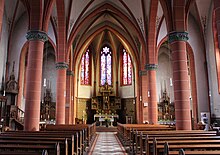Herz-Jesu-Kirche (Besseringen)
The Herz-Jesu-Kirche is a Roman Catholic parish church in Besseringen , a district of Merzig , district of Merzig-Wadern , Saarland . She bears the patronage of devotion to the Sacred Heart of Jesus . In the list of monuments of the Saarland the church building is a single monument listed.
history
The Catholics of Besseringen, along with those of Ponten (now a district of Besseringen) on the right of the Saar and those of Schwemlingen and Dreisbach on the left of the Saar, belonged to the parish of St. Gangolf , whose parish church was located between Besseringen and Mettlach on the mountain slope to Montclair Castle . Under Abbot Kleiner of the Benedictine Abbey of Mettlach , the first plans for the construction of a parish church in Besseringen-Ponten were made between 1773 and 1775, but the construction failed due to the resistance of the citizens of Schwemlingen and Dreisbach, as well as the disagreement between the Besseringer. In 1856, the St.Gangolfer pastor Christoph Schauffler had the plan to move the rectory to Besseringen, but this failed because of the Schwemlinger's resistance. In the course of the 19th century, further plans to relocate the rectory failed because of the Schwemling resistance.
Under Pastor Matthias Josef Zens, an agreement was finally reached in the church council of St.Gangolf in 1897 , which led to the sale of the mother parish to the von Boch family, so that the construction of a new parish church in Besseringen could be tackled. Only after difficulties with the parish members on the left of the Saar had been resolved and financial and legal questions had been clarified, could the building of the church be awarded on February 2, 1906 under Pastor Peter Krayer. Architect Wilhelm Hector ( Saarbrücken-St.Johann ) designed the plans for the new church . The contractor Ambré ( Waldrach / Mosel ) was responsible for carrying out the construction work . The foundation stone was laid on June 24, 1906 . On September 1, 1907, the last service for the parish took place in the church of St.Gangolf , the inventory of which was then brought to the new parish church in Besseringen. Two bells of the Gangolf Church, as well as the bells of the Besseringer Chapel , consecrated in 1497, were cast into a bell for the new parish church. The benediction of the church took place on September 8th, 1907, the consecration by the Trier auxiliary bishop Karl Ernst Schrod took place on May 18th, 1909.
Architecture and equipment
The church building was built as a three-nave hall church in the neo-Gothic style. It is a so-called step hall or pseudo basilica , the exterior of which gives a basilical impression. In contrast to a basilica, there is no window zone between the central nave and the lower aisles , a so-called upper aisle . Rather, the roofs of the separate aisles end almost directly under the eaves of the central or main nave. The church is divided into the west tower, visible from afar, the three-aisled nave , the transept and the five-sided polygonal choir .
The equipment of the church includes a Way of the Cross that still comes from the old parish church of St. Gangolf and figures of St. Gangolf and St. Sebastian , which also come from the old church. The winged altar in Gothic style is the work of the carver Karl Frank ( Trier ). The Binsfeld company (Trier) manufactured the two large windows in the transept. The stained glass in the choir windows refer to the veneration of the Sacred Heart.
organ
The first organ in the church was built by the organ building company Mamert Hock ( Saarlouis ) and had 15 sounding registers , distributed over two manuals and a pedal . During the Second World War , the instrument suffered severe damage, which was repaired in 1953 as part of a renovation. On November 13, 1997, the parish board of directors gave the organ building company Link ( Giengen an der Brenz ) an order to build a new organ, which was inaugurated on August 29, 1999.
The link-organ, a slider chests -instrument, has 32 stops on two manuals and pedal. The key action is mechanical, the key action electrically. The disposition is as follows:
|
|
|
|||||||||||||||||||||||||||||||||||||||||||||||||||||||||||||||||||||||||||||||||||||||||||||||||||||||||||
- Coupling : II / I, I / P, II / P
- Playing aids : 252 typesetting combinations, Zimbelstern
literature
- Kristine Marschall: Sacred buildings of classicism and historicism in Saarland . Institute for Regional Studies in Saarland, Saarbrücken 2002, ISBN 3-923877-40-4 .
Web links
Individual evidence
- ↑ List of monuments of the Saarland, partial list of monuments in the district of Merzig-Wadern (PDF; 320 kB), accessed on August 21, 2013
- ↑ a b c The church "Herz-Jesu" in Besseringen On: hein-familien.de. Retrieved August 21, 2013
- ↑ Information on the parish church Herz Jesu Besseringen on: www.kunstlexikonsaar.de. Retrieved August 21, 2013
- ^ Organ of the parish church Herz-Jesu Besseringen On: www.organindex.de. Retrieved August 21, 2013
Coordinates: 49 ° 28 ′ 29.5 ″ N , 6 ° 36 ′ 26.1 ″ E


